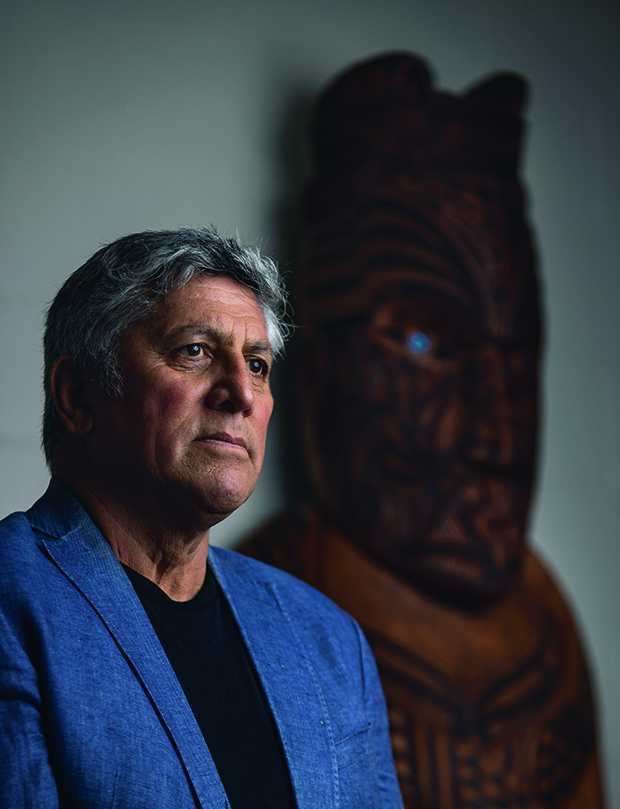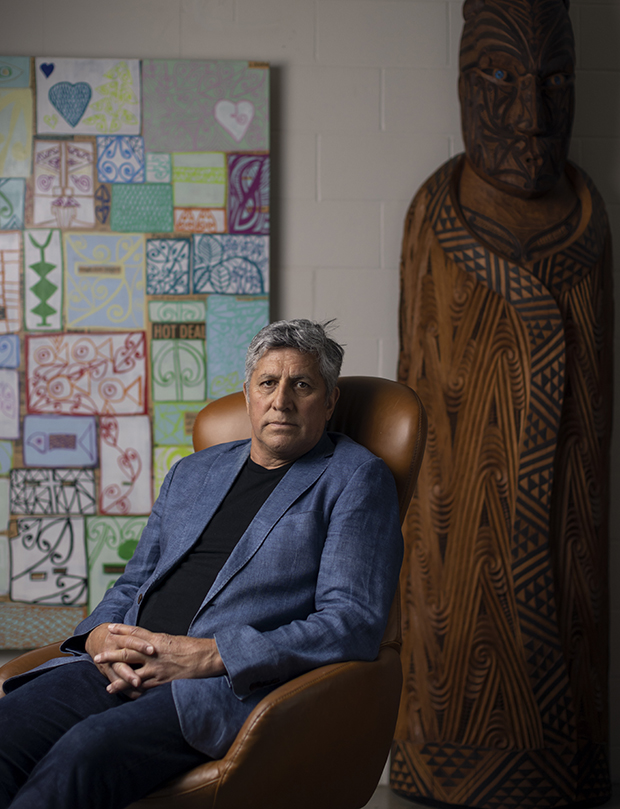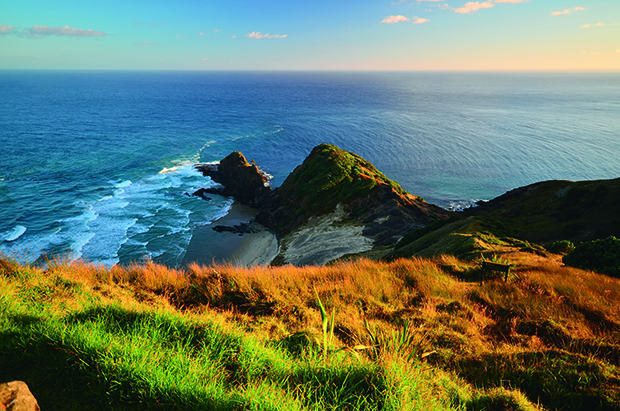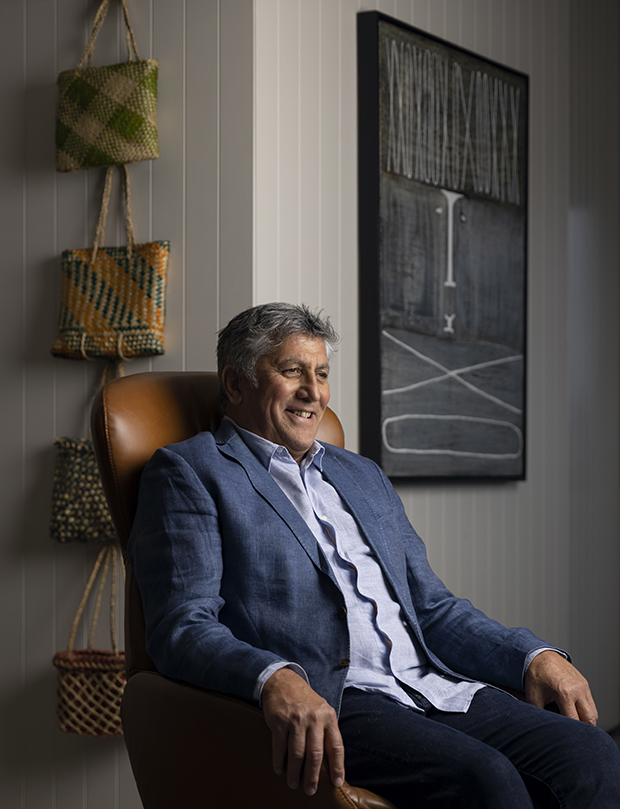Ngāti Kurī chairman Harry Burkhardt reflects on how his whakapapa impacts his leadership

Henri Jacques Burkhardt, aka Harry, considers himself a prodder of conventional wisdom, including his own. With Ngāti Kurī and Swiss whakapapa, he has come into his tribal leadership role comfortable occupying “grey spaces”. Despite his initially limited knowledge of Māoritanga, he ardently believes his tūpuna (ancestors) conspired for him to be here.
Words: Amokura Panoho Photos: Tessa Chrisp
PEPEHA
Ko Kurahaupō te waka
ko Pōhurihanga te tangata
ko Pārengarenga te wahapū
ko Te Hiku o te Ika te marae
ko Ngāti Wairoa me Ngāti Muhikaraka te hapū
ko Ngāti Kurī te iwi
ko Harry Burkhardt ahau
Kurahaupō is my waka
Pōhuritanga is my eponymous ancestor
Pārengarenga is my harbour
Te Hiku o te Ika my marae
Ngāti Wairoa and Ngāti Muhikaraka are my hapū
Ngāti Kurī is my tribe
I am Harry Burkhardt
Chair of the Ngāti Kurī Trust Board with commercial and governance experience, ranging from his own plastics-manufacturing and recycling business (Replas) to chairing government entities in health, tourism and economic development. He is also the president of the Packaging Council of New Zealand and, in 2015, was made a Member of the New Zealand Order of Merit for services to Māori and health.
WHAT DOES LEADERSHIP LOOK LIKE TO YOU?
I have a strong commercial background and understand and enjoy its pragmatic dynamics. We own plastics manufacturing and recycling plants in New Zealand and Australia, employing about 50 people. We supply products and services to multinational companies, which are used globally.
The principles allowing you to survive and thrive in a commercial world translate seamlessly into other sectors, i.e., be nice to the person with the money, do what you said you are going to do while having a weather eye on the legal implications of those decisions you make.
As I have built on my journey of success and failures, it has been important to distil those attributes that hold me grounded. When you are young and naïve, sometimes these are not obvious — concepts of servanthood, leadership, having a moral compass, accountability and followership are utilitarian and immutable.
Decision-making, when the runway is sometimes not clear or long, requires one to be uncomfortably comfortable in getting things wrong and moving quickly when you know you are wrong.
Working in values/principles-based and mission-focused organizations in high-trust, collaborative, safe spaces with people and planet first will invariably create the dividends we require.

WHAT’S THE ESSENCE OF LEADERSHIP?
The only way my journey makes sense is that my tūpuna have conspired for me to be here.
When my mother Ngāwini Ngauma and uncle Bob Wells nominated me onto the trust, knowing my lack of reo (language) and limited knowledge of our culture, it was my whakapapa that kaumātua (elders) and whānau recognized. It has taken a while to understand this, but that is what they saw in me, not what I thought I was bringing.
WHAT MADE YOU TAKE ON OTHER LEADERSHIP ROLES THAT YOU HAVE?
I had a bit of an epiphany when I went with the Te Hono programme at Stanford University with other sector leaders from New Zealand in 2015. Te Hono is the cornerstone partnerships programme across New Zealand’s food and fibre sector. Invitations are extended to chief executive or senior governance positions in primary sector companies, Māori agribusiness, educational institutes or government agencies.
We were provided an insight into a whole suite of new tools to tackle wicked problems. These were human-centered responses. You need people around you who think the same as you with similar purposefulness. I gravitate to those moments and those groups where we can have those conversations. Succession planning, building, and getting out of the road of our future leaders is our role as leaders.
One of the dynamics of stating that my tūpuna have conspired for me to be here is that it provides a backstop to the moments you overthink things. It also opens you up to an awareness and empathy that is invisible in a balance sheet and profit and loss accounts.
Many businesses and organizations may understand this at a transactional level; for iwi, hapū, whānau organizations, relationships and our activities sit in a spiritual ecosystem. Metaphorically putting our arms around people, customers, products, and services should reflect our provenance. While we learn to understand this, others may be able to see a like reflection.

PRACTICALLY, WHAT ARE THE CHALLENGES AHEAD FOR YOUR IWI?
In 2008 I was elected among 10 others as trustee to re-establish the Ngāti Kurī Trust Board and negotiate its treaty grievance with the Crown.
We still have a number of those appointed on the board today. We took the position that the treaty settlement process needed to be completed and yet the process didn’t define us.
Before settlement, we sought a commercial approach to building our future prosperity. So, since 2011, we have been focused on buying and managing assets that were returned to us through the treaty settlement process. We also purposely chose to avoid delivering Crown services.
We have three themes that guide us; shared prosperity, community resilience and mana motuhake, and we are hugely opportunistic in applying these goals.
We have invested in beef and sheep farms, avocado and blueberry orchards, tourism, honey, forestry and facilities management, and we have our own people managing and working in our businesses. Building that capacity and capability has been our focus. We currently have 90 staff, most whakapapa to Ngāti Kurī, with some 60 per cent of our workforce being wāhine.
Our iwi has a genuine interest in the concept that the rising tide lifts all ships. Although our whakapapa defines us, our manaakitanga reflects us to others.
So, for me, successful organizations will be people-focused. Our tikanga (customs) can guide how we behave and be accountable. We are still working out how to be open to all ideas, encourage critical thinking and focus on issues. We have an obligation to our future generations to ensure, at best, what we pass on does not have the baggage of the past still clinging.

WHAT CAN THE READERS ALIGN WITH AND GET ALONGSIDE TO SUPPORT?
We understand the value of building enduring relationships. We understand there will be those — sometimes your own whanaunga (relatives) — who have a different viewpoint. Different views need to be respected. Kotahitanga can mean moving together. I have watched the power and quality of collective decision-making when you respect that process.
ABOUT NGĀTI KURĪ
Ngāti Kurī are the tāngata whenua and kaitiaki (guardians) of Te Rerenga Wairua (Cape Reinga), the departing point of the spirits at the end of Te Ara Wairua, the spiritual pathway that leads along Te Oneroa a Tōhē (Ninety Mile Beach). Te Ara Wairua and Te Rerenga Wairua are of great significance to all Māori as the spiritual link to the ancestral homeland of Hawaiki.
Ngāti Kurī’s rohe (region) is generally described as north of Maunga Tohoroha (Mount Camel) in the east to Hukatere in the west and extending northwest to Motuapao Island, across to Te Rerenga Wairua and then east to Murimotu Island, including the islands of Manawatawhi (the Three Kings) and Rangitahua (the Keremadecs).
The Ngāti Kurī Trust Board is mandated to represent the political, social, economic and cultural interests of descendants of Ngāti Kurī and oversees the settlement. Signed in 2014, it included financial and commercial redress of $21 million as well as cultural redress, providing recognition of the traditional, historical, cultural and spiritual associations to several key sites, including Te Rerenga Wairua, Manawatawhi and Rangitāhua.
Their commercial interests have grown to a group equity of $39.6 million to include Ngāti Kuri Farms, Waimārama Gardens, Ngāti Kuri Tourism, Ngāti Kurī Mīere (beehives) as well as interests in Te Hiku Forest (Kaitāia). Their portfolio includes Ngāti Kurī Facilities Services, where they host visitors to Te Rerenga Wairua, Te Paki Stream, Taputaputa, Kapowairua and Rarawa Campsites.
Their social enterprise and environmental initiatives are at the Research Centre at Te Paki. Building on Wai 262 in recognition of kuia Saana Murray — one of the original claimants — they have significant partnerships with the scientific community, NGOs and philanthropists. This is guided by their mātauranga (knowledge systems) designed to restore relationships to taiao (environment), wai Māori/wai tai (freshwater/seawater) whenua (land) and moana (sea). The rohe of Ngati Kurī has the highest level of endemism in Aotearoa.
Love this story? Subscribe now!
 This article first appeared in NZ Life & Leisure Magazine.
This article first appeared in NZ Life & Leisure Magazine.
